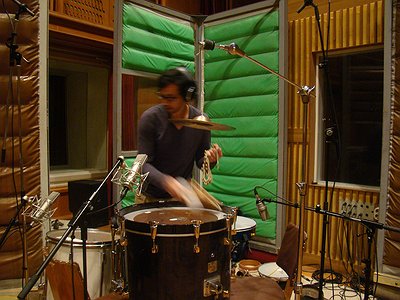Part 2
How do you see the relationship between sound, space and composition?
This is a big one, and I’ve thought a lot about it. We’ve a lot of new avenues to explore and express space now that virtual spaces and computer power have developed to the current state.
I’m intrigued by head tracking and locative / ambisonic sound IRL and in virtual spaces, but to me at the moment I feel like these are research outliers for my own work. There’s a lot to be learned from these explorations, but each time I’m tempted to move into those spaces specifically I can’t ignore the fact that having a 150 (or even 16) speaker system in a perfectly tuned room is far out of reach of many listeners.
[On the topic of composing in surround sound, read our Jean-Michel Jarre Interview about Oxymore, David Lynch and Audio Objects in Space]
The results from those experiments tell us a lot about sound perception and dissemination, how we can use sound in architectural spaces to enhance or extend our storytelling impulses, and for sure I’m excited to work in those spaces to develop my voice and my stories. To me, though, it’s ultimately a question of access. I prefer to bring it back to headphones / binaural, or stereo playback. It just seems the most accessible to me and to people in general, so I want to tune my stories to that context.
Activating space is a powerful gesture – I hear it all the time in my theatre work when I work with systems deployed in huge halls. In some festivals and theatres here they know if I’m coming they’ll have to hang extra speakers, or be ready to tailor playback to take maximum advantage of the system spatialization. I’ve been working so long that I’ve been able to form relationships with a lot of talented sound technicians here, and they are always up for the programming challenge each time.
What makes me feel like I’m doing it right in those spaces is that the sound reveals to me how it wants to speak. Hearing it in those spaces and through those speaker arrays with my sound tech makes me make different decisions for each play, for each story.
So, when I’ve the chance to work in these large halls, and be very focused in how I playback my designs and music and where they sit in relation to the audience’s ear, I learn a lot about how these gestures work in the storytelling process. When I work in smaller contexts for my own work (smaller spaces, galleries, headphones) I can apply some of those lessons in how I mix and place certain sounds in the listening field.
That being said: sound in a large space? Nothing beats it. Working with intimate and personal playback is more of a question of access to me, rather than preference, ultimately.
The idea of acoustic ecology has drawn a lot of attention to the question of how much we are affected by the sound surrounding us. What's your take on this and on acoustic ecology as a movement in general?
When, as a Canadian sound artist, I hear the term “acoustic ecology” my mind is immediately called to the work of the World Soundscape Project. As a movement, it’s undeniable the impact Schafer and his colleagues at the WSP have had on western academia and academic-centric sound practice (the WSP is the group that first brought the term “acoustic ecology” and “soundscape” to the fore, certainly in academic communities).
I would submit, however, that the boundaries and inherent value judgements made by that school are still in the process of being confronted fully, many excellent extant critiques notwithstanding (Sounding Out has a great series on this, or the absolutely fire quote of Schaefer’s that kicks off the incredible “Hungry Listening: Resonant Theory for Indigenous Sound Studies” by Dylan Robinson – I’ll not print it here as it is so horribly racist and offensive. Buy the book!).
There’s definitely a tension in the literature between acknowledging the impact that the members of the WSP and the acoustic ecology movement have had while questioning and rejecting some of the assumptions made about who listens, and how.
To me, there is a huge social disconnect in the traditional acoustic ecology between the utopian deification of “high fi” (natural) sounds (whose nature? Who consumes it, and how?) and “low fi” soundscapes (which define the soundscape of the vast majority of the population of the world) that the WSP assumed and expressed at its core (despite later attempts to expand their notions in practice). If you’re poor, if you’re brown, if you’re stuck in the city with no means to travel or even access to “nature” (or if access has been stolen from you from a government continuing to practice institutional racism), does your soundscape hold no value or meaning?
There are other theorists and thinkers who have delved into this question more deeply than I (see above), but suffice it to say that from my perspective, I distrust the term “acoustic ecology” deeply. I personally find very profound undercurrents and meaning in sound environments that have often been classified and written off as harmful by traditional acoustic ecology adherents. There’s no doubt that, e.g. loud urban spaces have a detrimental effect on health and social interactions, but I think that those issues, while necessary to address, do not negate the rich and complex relationships that humans have with their urban sound environments, and to neglect that relationship in favour of an exclusionary, utopian (and yes, racist) consumption of nature is deeply flawed.
But further, a fundamental and irrefutable thesis: every recording is incomplete and a failure. It is a finger pointing at the moon.
From the concept of Nada Brahma to "In the Beginning was the Word", many spiritual traditions have regarded sound as the basis of the world. Regardless of whether you're taking a scientific or spiritual angle, what is your own take on the idea of a harmony of the spheres and sound as the foundational element of existence?
The drone in music from the Indian subcontinent is ever-present. I recall reading about the tanpura, the 4 stringed instrument that most often provides the drone. The tanpura makes a very striking and specific sound that has I daresay taken hold in much of the sound vocabulary for anyone who is remotely interested in music from the global south – I have a hard time imagining anyone curious about music or sound who hasn’t heard it at least once.
Anyhow, what I remember reading was about the function of the tanpura in the music traditions of north and south India. The person writing said that the tanpura is the manifestation of every note in the universe, and the performer plucks the pitch they want in the moment out from that cloud of all possible sounds.
What’s interesting to me in this explanation is the acceptance of the fact that there is no “wrong” sound, ever. There is just the sound chosen to be expressed in that moment. And the fact that that one particular pitch is chosen does not negate the value of all the other sounds not chosen but still present in that moment. All the unchosen sounds are still sounding – it is our attention that is moving.
One of the main religious festivals for Bengalis is the festival of Ma Durga, the 10 armed Goddess who slays the demon Maheshasura. Flowers are offered at certain points in the festival to the demon, accepting and revering his place in the process of the destruction of evil. In some areas of rural Bengal and further afield, there are tribal communities that venerate Masheshasura as a leader, who was slain because he dared to confront and fight the gods. Again we see and practice the acceptance of both sides of the coin, to venerate all aspects of life, a complicated but acknowledged relationship between desire and non-attachment, both needing to exist in order to maintain balance.
People more expert than I can comment on the Nada-Brahma but one of the ideas that always struck me is the idea that the syllable “Om” is actually a harmonic of the sound of the universe, and that the Sanskrit language properly spoken resonates in sympathy with these sound (we could unpack the roots and origins of this idea quite fully, as I’m sure it intersects with caste and religious politics in ancient and modern times, but it is a powerful idea nonetheless).
I will say that the idea of a cloud of sound that the universe makes, a cloud ever-present that reveals itself as we attend to it – this idea is a powerful beating heart, and it lives and resonates with me on many levels. It’s an expression of an immensely complicated and often inconsistent cultural tradition that, having grown up in pre-internet central Canada, I cannot quite (or ever) fully understand, but it is one that allows me a pathway into understanding or framing my fascination with sound.
Taking this further (and here I’m just riffing, not aiming anything at 15 Questions in particular): the concept of “Nada-Brahma” is one that is founded on a profound system of thought and transmitted knowledge. I think evoking terms like these in the context of sound art could potentially perpetuate a discourse that is historically prevalent in western sound studies, one that perpetuates a fetishization of listening and knowledge systems and also attempts to subsume, dilute, and redefine them in more palatable or easily understood terms.
We need to unpack the desire to look for or express concepts such as these – why is it that we need them in talking about sound? What does it say about our own understanding, our own desire to consume and own knowledge? How does relying on such culturally specific viewpoints contribute to our own “hungry listening”?
I have family in India, and I know that the way I talk about my work and what I’m trying to uncover has been repurposed and weaponized to contribute to oppression of many communities in India and abroad. So I think it meet that I mention here that the way I speak about my sound practice, and the conceptual framework I erect around it, is by no means intended to be a utopian, exclusionary or exclusive set of rules or concepts available only to me or the Hindu community. I speak about it as merely the form that fits the content and intent of what I do. It’s an effort, full of gaps and holes, to understand sound and the power that it has over me, and the power that lies within it.
The world is a beautifully complex and complicated place. It behooves us to embrace and wrestle with all the harmonics of our being in it. I want all of it to hum through everything I do – it’s a big undertaking, and failure lurks, but I want to make sure I ask it of myself, everyday.






